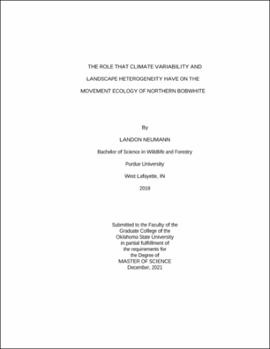| dc.contributor.advisor | Davis, Craig | |
| dc.contributor.author | Neumann, Landon | |
| dc.date.accessioned | 2022-05-13T19:05:17Z | |
| dc.date.available | 2022-05-13T19:05:17Z | |
| dc.date.issued | 2021-12 | |
| dc.identifier.uri | https://hdl.handle.net/11244/335780 | |
| dc.description.abstract | Movement is a fundamental characteristic of life influencing survival and population connectivity. Therefore, understanding how animals move is critical to their conservation in a changing world. Animal behavior is influenced by many different factors including diel and seasonal rhythms, climate variability, and changes on the landscape. Furthermore, climate change is predicted to increase the intensity and frequency of climate extremes, threatening biodiversity and altering ecosystems. Understanding how animals use move in response climate extremes will be critical for understanding how to maintain animal populations into the future. Sedentary species are predicted to be more negatively impacted by climate extremes because they require predictable resources. Limitations in technology has prevented researchers from understanding how these factors influence the movement of many small species (<14 kg) including Northern Bobwhite (Colinus virginianus; hereafter bobwhite). We investigated how the movement ecology of bobwhite, a small sedentary declining galliform, is influenced by diel and seasonal rhythms, climate extremes, and changes on the landscape at a fine temporal scale. We collected global positioning system data on Northern Bobwhite across western Oklahoma during 2019-2020. We acquired meteorological and vegetation data from the Oklahoma Mesonet, rangeland analysis platform, and calculated normalized difference vegetation index from Pleiades imagery. We used a generalized linear-mixed or a linear-mixed modeling approach to analyze our data. Our findings suggest that diel and seasonal rhythms shaped bobwhite movement. Bobwhite were most sedentary during winter. The daily bimodal movement pattern exhibited by bobwhite may reflect behavioral tradeoffs aimed at increasing survival. The interaction between multiple climate variables influences this species' movement patterns. Bobwhite movement appeared most limited during extreme cold or heat in conjunction with solar radiation. Our findings suggest that bobwhite use habitat differently during different climate extremes reinforcing the need to manage habitat that allows species like bobwhite to tolerate a wide range of climate extremes. In addition, different climate extremes alter how changes on the landscape influence the movement of some animals. Our study stresses the need to manage for landscape heterogeneity to allow animals to tolerate climate extremes by increasing their realized thermal niche on the landscape. | |
| dc.format | application/pdf | |
| dc.language | en_US | |
| dc.rights | Copyright is held by the author who has granted the Oklahoma State University Library the non-exclusive right to share this material in its institutional repository. Contact Digital Library Services at lib-dls@okstate.edu or 405-744-9161 for the permission policy on the use, reproduction or distribution of this material. | |
| dc.title | Role that climate variability and landscape heterogeneity have on the movement ecology of Northern Bobwhite | |
| dc.contributor.committeeMember | Fuhlendorf, Samuel | |
| dc.contributor.committeeMember | Elmore, Dwayne | |
| osu.filename | Neumann_okstate_0664M_17431.pdf | |
| osu.accesstype | Open Access | |
| dc.type.genre | Thesis | |
| dc.type.material | Text | |
| dc.subject.keywords | air temperature | |
| dc.subject.keywords | animal movement | |
| dc.subject.keywords | climate change | |
| dc.subject.keywords | climate extreme | |
| dc.subject.keywords | colinus virginianus | |
| dc.subject.keywords | season | |
| thesis.degree.discipline | Natural Resource Ecology and Management | |
| thesis.degree.grantor | Oklahoma State University | |
